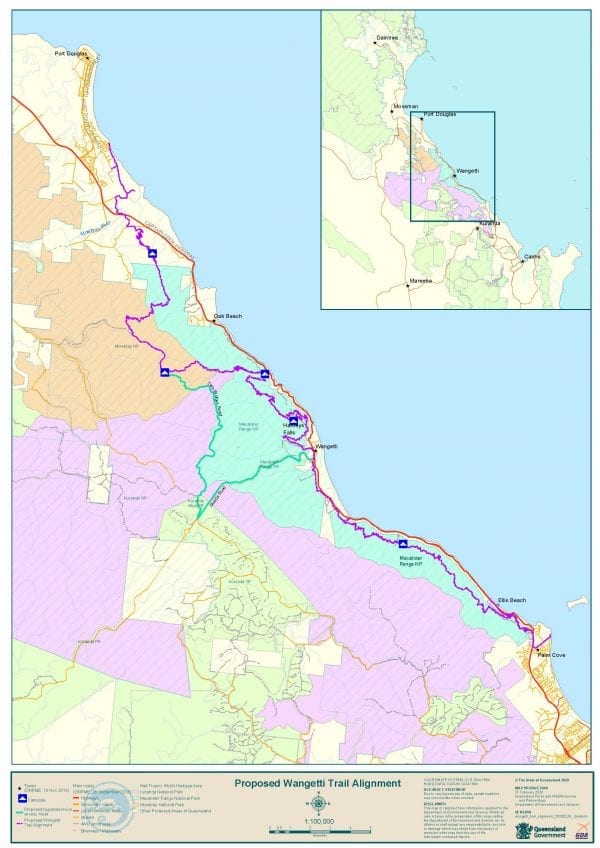Submission Re EPBC Referrals Wangetti Trail North and South 2020/8722 and 2020/8723
By William Sokolich, Speewah, Queensland
There are several important issues that would support the Referral of the Wangetti Trail North and South to be classified a Controlled Action.
Firstly however, I’ll just make a comment on the submission timeframe; 10 business days is not near enough time for projects in World Heritage Areas. Further, reports and assessments made by the public body the Wet Tropics Management Authority were not made public before the Referral was posted and are not presently to my knowledge.
I may have a misunderstanding re the process of the Referral and a Controlled Action. I thought that a decision would be made before governments made commitments to funding construction. The Commonwealth’s AusTrade, announced via the Qld Tourism and Innovation Minister Kate Jones, that a 9 million dollar grant for design and construction work had been awarded in July this year for the Wangetti Trail. That does seem to strike at the heart of this process and pre-empt decision making. I will still make my points in good faith.
The Wet Tropics World Heritage Area (WTWHA) is considered one of the top ten most irreplaceable, genetically and culturally important World Heritage Areas (WHA) in the world. These top world ratings require special attention. The Commonwealth can insure the world gets a national assessment by declaring a Controlled Action over the proposed project. There are several aspects to the proposal that could negatively impact of its Outstanding Universal Values including:
- The total clearing of 60 ha of undisturbed parkland with the majority being excavated as well, to varying depths, which involves total removal / destruction of World Heritage biota.
- A 400ha building envelope, ‘track reserve’ which is subject to disturbance during construction, maintenance and for future detours and changes in track alignment. The impact of the track and works envelope / reserve will bring up the total cleared area substantially, likely in the 100ha range. This is a far and above the 1.5 ha that places clearing in WHAs on the EPBC Referral list.
- The Black Mountain corridor is the narrowest point in the WTWHA and one of its most sensitive. Evolutionary processes are likely to be disturbed.
- Helicopter use in construction and future maintenance and emergencies. Helicopters hugely impact on any wilderness values as well as wildlife patterns. It’s certainly unknown what near and longer term impacts would be placed on the endangered Cassowary.
- The entire track and construction reserve are mapped by the Qld government as Cassowary habitat with active populations present. There was no mention I could see of any Cassowary Recovery Plan. I also did not see any references to impacts on Cassowaries during construction or ongoing contacts with mountain bike riders, walkers, campsites or built accommodation nodes. It is well known that Cassowaries will use built tracks in their territorial range and interact with people at campsites and trails. Impacts on endangered fauna must be determined and if there is not a recovery plan in place then, one must be approved before works can start.
- State consultation on stage one and two is being conducted by the office of Tourism and Innovation and not the Dept of Environment and Science, focusing on ‘trail alignment’ and social issues rather than in depth environmental matters. It would be far more appropriate in a WHA to have a full EIS prepared for public comment as part of EPBC legislation.
- The Referral docs indicated that permits to construct have been granted by WTMA. I am not aware of any consultation, call for public submissions or studies provided to assist the public with detail on the proposal by WTMA. The public needs the EPBC to ensure full public participation.
- There will be erosion and sediment loss from the project area during construction and its ongoing use, primarily from the tracks interference with natural drainage lines and from mountain bike use once in operation. The drainage discharges into the Great Barrier Reef World Heritage Area. Estimates on the sediment load during construction and its ongoing life must be assessed to ensure it does not threaten its integrity. A Controlled Action is needed to assess impacts on the GBRWHA.
- There was no mention of climate change forecasts which predicts cyclones with higher wind speeds and more intense rainfall events. We have the super cyclone Yasi and the Townsville floods where 2,500mm of rain fell in five days as stark examples. Those weather extremes must be factored in, not just for the environment but also to evaluate risk levels over the whole project to ensure it does not become a stranded asset, as is the case with several Whitsunday resorts and Port Hinchinbrook. Provisions for climate change adaptability must be drafted with risk assessments.

National Parks Association of Queensland
This map is conceptual only and subject to approvals.
The Wangetti Trail Proposal plans to introduce mountain biking and private accommodation (new activities/impacts) into Macalister Range National Park, Mowbray National Park, Kuranda National Park and the Wet Tropics World Heritage area.
